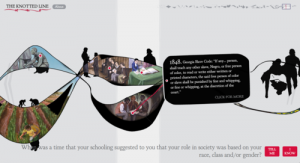This is a very hot take and I’m only up to page 13, but I’m posting this anyway.
I want to like this reading selection because I think it’s important to question how our cultural beliefs about logic and computing affect social structures… but I don’t like it. I think the introduction comes off as overwrought, self-serving hand-wringing and it’s really putting me off.
As I was reading this I thought of Richard Jean So’s article “All Models are Wrong.” The picture Drucker paints of the DH world is a model. Maybe in 2009 DH was as unthinking as she portrays, or maybe she distant read digital humanities projects without close reading the thinking around them to test her assumptions. I’m not in a position to say, with my 2018 perspective and only 5 weeks of studying the field. What I can point out is that this piece is riddled with absolutisms and sweeping declarations that strike me as iffy. To me, it feels like Drucker’s read of the DH field and DH projects lacks the very nuance, sensitivity and interpretism (whatever spellcheck, it’s a word if I want it to be) that she claims are missing in the DH work she critiques.
Drucker claims that consideration of design as a means of communication and usability, “plagues the digital humanities community” (p. 6). This is a cheap shot on my part, but has she actually used many DH tools? The user experience for many of them quite closely aligns with design as meditation, freestyle, or opportunity for idiosyncratic thinking.
Also what the hell is that weird conversation on page 12 where Drucker is trying to demonstrate that XML doesn’t communicate flirting?
In the example Drucker gives, a woman is bewildered and a man is “graciously” giving that woman knowledge and validation. The woman has big blue eyes that drop submissively as she blushes and asks him to guide her. No aspect of the man’s physical appearance is described. As always, it’s women who are fair game objects of a one-directional, sexualizing gaze.
I’m going to go stress eat about sexism (haha, I’m such a woman!). If, when I come back to this, further reading makes me reconsider these POVs, I’ll mea culpa in the comments.


